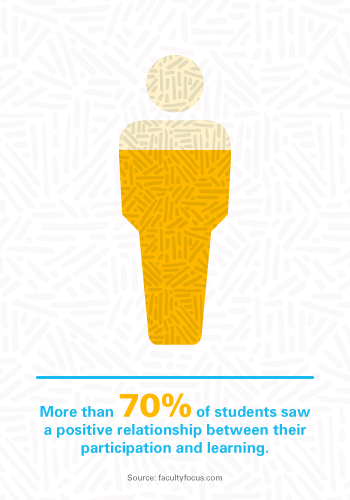
Student participation is an important aspect of teaching. Learners who engage in student participation activities retain more information and give their teachers important visibility into how they understand concepts.
In a study by Faculty Focus, more than 70% of students saw a positive relationship between their participation and learning. They also saw value in other students’ comments in class. These students felt that classroom participation helped confirm what they’d learned, facilitated retention of the information, provided clarification and deepened their understanding of topics.
That said, participation in class can be difficult for teachers to foster, especially in large classes. Many students my find it hard to voice their opinions or questions in front of a group. It’s imperative to create an environment where all students feel encouraged to speak up, ask questions and express their excitement or concerns. Teachers must continually break down barriers to ensure that students are being active in their learning. Active learning, where students are engaged with each other and their teachers, results in better outcomes.

Inspiring active learning can be done in many ways, but primarily it comes from encouraging students to work with their classmates in engaging classroom activities that allow them to ask questions, display their understanding of topics and learn from their classmates. The payoff is two-fold. In this environment, teachers can observe and quickly gauge areas where multiple students are struggling to understand a topic. Student participation activities can help both educators and students do their best.
Student Participation Activities
A great way to encourage student engagement for every age group is using hands-on activities in the classroom that get everyone involved. Try these student participation activities and printable downloads to get your classroom engaged.
Response Cards
Some students aren’t as comfortable speaking up in class as others. Response cards offer an alternate way for even the shyest students to engage in the classroom without anxiety. Response cards can be used throughout a variety of subjects and allow all students to have their voices heard without talking over each other.
- Create common responses to classroom discussion questions. You can download our printable response cards here.
- Explain when you’ll be using the response cards. For example, if you are going over reading material, let your students know that they’ll be using response cards to answer your questions about the material.
- Explain to the students that they should keep their cards facing toward you so they feel comfortable in their anonymity.
- Let the students know that there are no right or wrong answers, and the response cards are meant to help you adjust your lessons to their needs.
- When using response cards, look around at the responses and decide if they warrant further discussion. This can be done without calling a student out by name and simply diving into both sides or a misunderstanding.
Advance Your Teaching Career
CU’s online Masters of Teaching in High School Education prepares you with the methods you need to increase classroom participation, engage your students and make sure they’re ready for college and the workforce.
Learn MoreGallery Walk
A gallery walk is a tremendous way to encourage teamwork and give everyone in the class a chance to engage with and understand the material being taught. It also gets students out of their chairs and talking with their peers in a productive manner.
- Post discussion questions related to a current curriculum topic around the room. Three to five questions is usually a good amount, depending on the size of your class.
- Split your class into the same number of groups as there are questions. It’s important that the groups aren’t too large so everyone in the group is able to provide feedback.
- Allow the groups time to answer each question and write their feedback down on a sheet. Download our feedback template here.
- Each group will answer the question and add on to the previous group’s content.
- At the end of the activity, you will have a comprehensive look at how the class is grasping the material.
- Discuss the content with the class as well as any questions they had.
A-Z Topic Reflection
This activity can be done alone or with a group and will require your students to think deeply about material they’ve just learned. Creating an A-Z topic summary also helps you understand what your students have picked up from a book or lesson module.
- Ask your students to write a word or sentence summarizing what they’ve learned for each letter of the alphabet. Use our worksheet for this activity for ease.
- If you have a large class or work with young students, group students or assign individuals just a few letters to write summaries for.
- Allow students to share their words or summaries for each letter with the class if they’d like.
Peer-Generated Testing
This activity truly makes students reflect on the material they learned, as well as gives them a chance to hear what others have learned. A peer-generated test allows students to come up with questions about material as opposed to just answer questions.
- After you finish a lesson, instruct students to prepare a few test questions related to the lesson material as well as the answers to those questions. We’ve prepared a template you can give your students to keep things organized.
- After each student has prepared questions and answers, pair them with another student so they can quiz each other. Do this as many times as you’d like so that students get to answer different questions from multiple students.
- Ask some students to share their questions and answers with the class after the activity.
Student participation has long-lasting effects on students, allowing them to retain information, build confidence and relationships and learn from their peers. Use these engaging classroom activities and others to ensure that student participation in your classroom increases.
For more ideas on how to encourage student participation and influence classroom engagement, consider an online master’s of teaching in high school education. Campbellsville University’s program prepares you with the methods you need to increase classroom participation, engage your students and make sure they’re ready for college and the workforce.
No matter what age group you teach, student participation is important. Check out all of the online education master’s degrees offered by Campbellsville University to find one that meets your needs.
